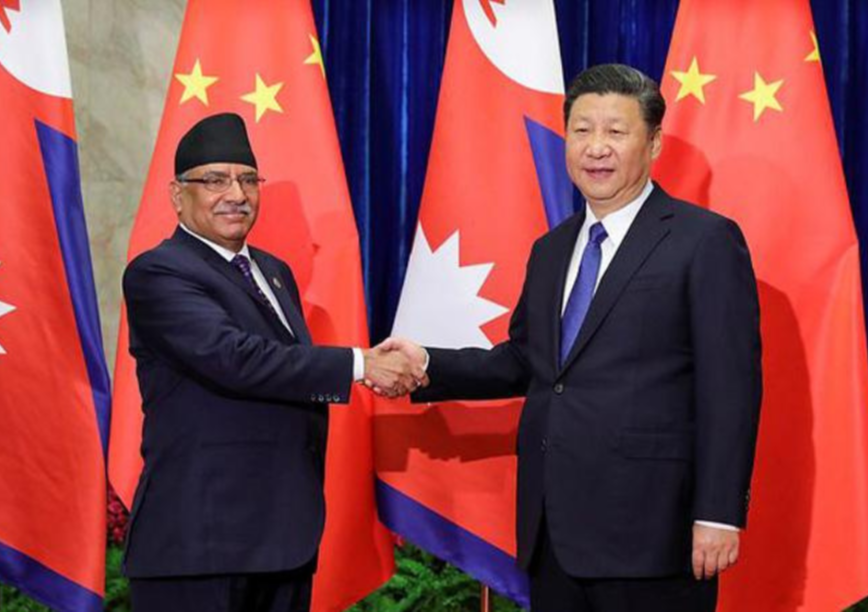
The Pokhara International Airport was in the spotlight once again after a report that was recently released highlighted multiple oversights, from the airport’s bidding process to its construction, deeming it an albatross hanging around Nepal’s neck. While there has been no official comment from the Nepal government, the report comes against the backdrop of Prime Minister (PM) Pushpa Kamal Dahal, ‘Prachanda’s’, trip to China last month. Post his visit, the PM considered it successful in reinforcing the ‘Strategic Partnership of Cooperation Featuring Ever-lasting Friendship for Development and Prosperity’ between the two countries. Before leaving for the visit, Nepal had highlighted certain priority areas that it would take up with China—the financial modalities for the big-ticket projects funded with Chinese support; the agreement on power trade; Nepal’s trade deficit with China; and Kathmandu’s sovereignty concerns after Beijing released a new Chinese map—all of which failed to find a place in the joint statement.
Vouching for increased connectivity
After delivering his speech at the United Nations (UN) General Assembly, the Prime Minister flew directly to China where he met the Chinese President in Hangzhou and held delegation-level talks with his counterpart, Li Qiang, at the Great Hall of the People. The week-long visit (September 23-30) saw the signing of 12 agreements, which included seven Memorandums of Understanding (MoUs). As per the joint communiqué, the visit focused on three priority areas—connectivity, security, and sovereignty. On connectivity, both sides reaffirmed their willingness to strengthen connectivity in ports, roads, railways, airways, and grids. Both agreed to resume work on the Trans-Himalayan Multi-Dimensional connectivity network and Nepal welcomed the opening of the Lizi-Nechung port and the Zhangmu-Khasa port. The Chinese side also agreed to repair the Syaphrubesi-Rasuwagadhi Highway and approved the launch of the construction of the 220 KV Cross-Border Power Transmission line from Jilong/Keyrung to Rasuwagadhi/Chilime. China also committed to reopening the border points that have been closed since the COVID-induced lockdowns. The countries also welcomed the arrival of the first tranche of turmeric from Vietnam to Nepal via Tianjin port in China and the Zhangmu Tatopani border point under the Nepal-China transit transport agreement.
Both agreed to resume work on the Trans-Himalayan Multi-Dimensional connectivity network and Nepal welcomed the opening of the Lizi-Nechung port and the Zhangmu-Khasa port.
Owing to certain developments over the past few months and China’s unilateral attempts to co-opt non-Belt and Road Initiative (BRI) projects under its ambit, there was also some expectation that Kathmandu would clear its stand on the financial modalities surrounding large infrastructure projects. However, the joint statement only referred to an agreement to “complete the text of the BRI implementation plan at an earlier date.” The two sides also signed MoUs on digital economy, green and low carbon development, and agriculture, and they also discussed the need to facilitate more Nepali exports to China to address the trade deficit. While China has allowed around 98 percent Nepali exports to China with no tariff, most rot at the border. The trade deficit between the two has been a cause of concern for Nepal for some time now. Beijing also offered assistance in capacity building with training for Nepali railway professionals, disaster risk reduction, and the provision of language training by opening up more Chinese language centres. It also highlighted the importance of the Confucius institutes and Chinese cultural centres in promoting the bilateral relationship.
Ambiguous security cooperation: Beijing’s advantage?
On the question of security, while Kathmandu refused to sign the Global Security Initiative because of its commitment to its non-aligned foreign policy, it joined the Group of Friends of the Global Developmental Initiative. But despite the categorical denial of forging any security ties, the joint statement mentions joint inspection of the Nepal-China boundary and cooperation between the law enforcement agencies of both sides, indicating some degree of security cooperation. The two also agreed to expedite the ratification of the China-Nepal treaty on mutual legal assistance in criminal matters. The PM stated Nepal’s support for “..important concepts and initiatives put forward by President Xi Jinping..” during his bilateral talks with the Chinese premier. This ambiguity reflects Kathmandu’s reticence to formally get on board any Chinese-led security initiative but also balances its outright rejection with verbal support and indirect cooperation.
Kathmandu’s failure to evince reciprocal support for its sovereignty concerns while being so open about China’s sovereignty is evident.
A few months ago, China released a new map, which didn’t use Nepal’s standard map released in 2020. This created an uproar in the country with the Opposition and people wanting the PM to raise it with the Chinese side during the talks. While the statement mentions Nepal’s commitment to the ‘One China principle’ as opposed to ‘policy’ which was the standard practice before this, it also includes Taiwan’s name along with reinforcing its support for Tibet as well. Prachanda also met some Chinese officials in Tibet. In this respect, Kathmandu’s failure to evince reciprocal support for its sovereignty concerns while being so open about China’s sovereignty is evident. It wasn’t mentioned in the joint communiqué or any statements released by the Ministry of Foreign Affairs, the prime minister’s private secretariat, and the Nepali Embassy in Beijing, even though the PM alluded to taking up the issue with Beijing.
A success or a missed opportunity?
The Prachanda-led government has heralded the trip as both an ‘economic and diplomatic success’, however concerns remain. First, while both sides welcomed the opening of the airport in Pokhara, the airport has seen no traffic, with the only flight landing there in the last few months being the Chinese government-sponsored flight carrying its athletes for a goodwill dragon boat race. Kathmandu also couldn’t get a definite response from India, when Prachanda visited New Delhi in June, on whether it could consider opening its air routes to flights from the airport. Now, the recent allegations of the Chinese company working on the airport disregarding Nepali oversight over the project and ignoring ecological assessments have exacerbated the concerns further, making the prospects of the airport getting international traffic more bleak. Almost a month before the trip, there were reports about the government making a formal request to the Chinese side to waive off the approximately US $215 million loan for the airport and also for the five Chinese-made aircraft that were operated by the Nepali national carrier as they were incurring losses.
The PM had also stated that Nepal would seek a Chinese grant for a mega project under the BRI. But there was no reference to this in the statement or the press conferences. While the Chinese Ambassador has rubbished claims about the debt trap as a deliberate ploy to jeopardise the relationship, some government officials were not confident of other important projects like the Nepal-China Railway Line moving forward in the absence of any Chinese grants. The PM expressed hope that the Chinese side may review its investment policy in certain aspects. He also blamed the delay in the implementation of BRI projects on the pandemic and the country’s infrastructural limitations. The visible obfuscation of the Chinese loans at high-interest rates and the unilateral actions from China under which it co-opted non-BRI projects within its ambit indicate Prachanda’s reluctance to broach any uncomfortable topic publicly. On 8 October, while the PM said that the BRI implementation would progress on a priority basis, the secretary of the Prime Minister’s Office ruled out the possibility of any important agreement under the BRI to be signed at the third forum of the BRI in China.
The visible obfuscation of the Chinese loans at high-interest rates and the unilateral actions from China under which it co-opted non-BRI projects within its ambit indicate Prachanda’s reluctance to broach any uncomfortable topic publicly.
Many consider Dahal’s failure to broach the grant issue as a ‘missed opportunity’. But it is imperative to understand whether Kathmandu could get its point across without putting into limbo its relationship with Beijing. The resumption of the feasibility study of the Jilong/Keyrung-Kathmandu Cross-Border Railway with no final verdict on the funding modality puts this project at risk of being another albatross. Chinese projects in Nepal have also recently been under the scanner for flouting environmental regulations. At the Tinau Rural municipality, locals protested against a crusher plant that did not undergo the mandatory Initial Environmental Examination (IEE) and Environmental Impact Assessment (EIA) before making the plant operational.
A tough balancing act
Nepal always insists that its relationship with both India and China is independent of each other. But as the cleavages between the United States (US) and China expand and the latter attempts to increase its presence in Kathmandu, it has become imperative for Nepal to balance its ties and hedge against the possibility of further divergences between both Washington and Beijing as well as the latter and New Delhi. Since the signing of the compact grant of the Millennium Challenge Corporation (MCC) project, Beijing has become more cautious about the US efforts to expand its influence. Prachanda wanted to use the trip as an opportunity to convince China that the MCC had no security or strategic considerations. To assuage Beijing’s concerns, Nepal also opted out of the State Partnership Programme owing to concerns about being viewed as anti-Chinese. For Beijing, Nepal’s cooperation on the Tibetan issue is also important vis-á-vis its ties with India.
For India, the positive momentum generated after the Nepali PM’s recent visit to New Delhi and its focus on the ‘mutual convergences’ between the two neighbours will propel the relationship forward in the foreseeable future. But as this visit indicated, while China’s failure to effectively address Nepal’s concerns about the trade deficit and the conversion of loans into grants will prod Kathmandu to seek close cooperation with India, its inability to raise complicated issues with Beijing will be a cause of concern for New Delhi.
Shivam Shekhawat is a Junior Fellow with the Strategic Studies Programme at Observer Research Foundation
The views expressed above belong to the author(s). ORF research and analyses now available on Telegram! Click here to access our curated content — blogs, longforms and interviews.




 PREV
PREV


